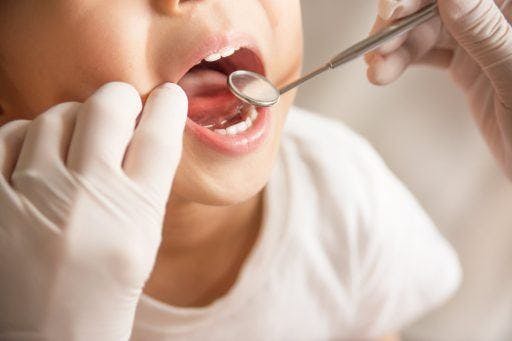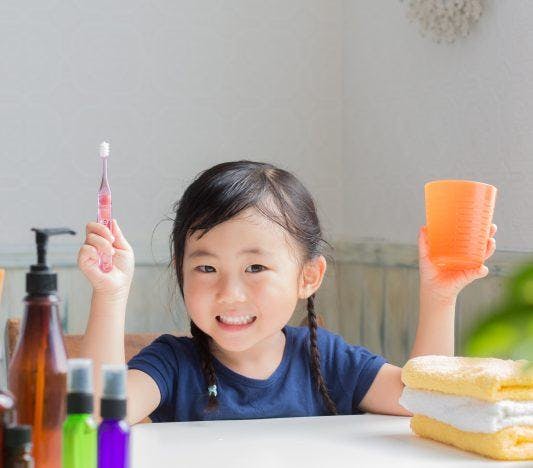Did you have crooked teeth while growing up? If so, you might want to explore techniques to improve your kids’ chances of developing straight teeth. While genetics certainly factor into how a person’s smile turns out, there are other things to consider – including habits, hygiene, and diet. Here’s how to put your child on track to healthy, well-aligned teeth.
A Few Common Causes of Kids’ Crooked Teeth

To better understand how to get straight teeth, you first need to know what leads to misalignment.
1. Genetics and evolution
Is it normal for kids to have crooked teeth? Research shows that genetics plays a role in teeth and jaw formation. If your family has a history of misaligned teeth, then your child may develop the same. Overbites, underbites, and crowding are dental conditions you can inherit from past generations.
However, anthropologists believe that malocclusions are a modern phenomenon. Cavemen had straight, uniform teeth – their fossils attest to their lack of dental issues. The prevailing theory is that early humans had oversized jaws for rigorous chewing. Over time, the average diet evolved to include softer food, which led to smaller jaws and misalignment.
2. Poor myofunctional habits
Poor myofunctional habits refer to behaviours that negatively impact your kid’s mouth muscles. Some examples are thumb-sucking, mouth-breathing, and prolonged pacifier or bottle use.
3. Inconsistent oral hygiene
There’s no overstating the importance of proper oral hygiene in developing strong, healthy teeth and preventing dental issues. The Centers for Disease Control and Prevention (CDC) identifies cavities as the no. 1 most common chronic childhood disease in the U.S. In Australia, one in 10 people over 15 had poor dental health. In Singapore, 40% of children under six had early childhood caries.
When left untreated, cavities can reach the root of the tooth, leading to severe toothache and infection. In other cases, they can make the affected tooth brittle and prone to breakage. On top of that, kids who don’t practice consistent oral hygiene may struggle to take care of their permanent teeth later.
4. Premature tooth loss
Here’s one more reason it’s critical to avoid childhood cavities: premature tooth loss. Since decay slowly destroys and weakens teeth, they can become loose and fall out. Baby teeth are supposed to come out when a child is between ages six to 12. If your kid loses them earlier, their remaining baby teeth can crowd the area where permanent teeth are supposed to grow.
How to Help Your Kids Develop Straight Teeth

Now that you know how crookedness develops, you can work on preventing it.
1. Encourage good oral hygiene practices.
Teach your kids proper oral hygiene techniques from a young age. Eventually, it’ll become a habit for them, and they won’t need to rely on you to care for their teeth. The CDC recommends that parents supervise children (especially those under six years old) since they’re still learning to brush effectively.
Make sure they’re using a pea-sized amount of fluoride toothpaste and that they spit after gargling. As recommended by dental health professionals, they should also be brushing for at least two minutes twice a day. You can teach them how to floss once their teeth start fitting closely together, which happens when a child is two to six years old.
2. Wean them off their sucking habits.
Babies and toddlers have natural rooting and sucking reflexes. Thumb-sucking makes them feel safe and secure, so many children use it to self-soothe very early in life. According to Stanford Medicine Children’s Health (SMCH), “Thumb sucking is normal in young infants and children,” but the habit should ideally stop by age five to avoid permanent damage.
If your child persists in thumb-sucking past this age, it can interfere with adult teeth development, leading to problems like protruding incisors and crookedness. SMCH notes that pacifiers may be a suitable alternative since they’re gentler on baby teeth. However, you may want to correct the behaviour sooner, especially if they’re particularly aggressive with it.
3. Provide proper nutrition.
As The Harvard T.H. Chan School of Public Health puts it, “A balanced diet with adequate nutrients is essential for a healthy mouth [and] a healthy mouth supports nutritional well-being.” So, the development of problem-free teeth starts with a balanced and nutritious diet.
Minerals like calcium and phosphorus can protect and rebuild enamel, which keeps teeth strong. High-calcium and high-protein foods, like cheese, milk, and eggs, also contain fat-soluble vitamins like A, D, and K2 to boost calcium absorption further. Hydrating, high-fibre fruits and veggies help clean teeth while neutralising damaging acids. Lastly, make sure they drink lots of water!
4. Visit your dentist regularly.
Experts recommend parents take children to the dentist within six to 12 months of their first tooth erupting. You can also bring them in earlier if there are urgent concerns, like accidental tooth loss. During the first meeting, your dentist will perform a thorough exam and provide recommendations for upkeep.
Your child should visit the dentist every three to six months, depending on the state of their teeth. For some, once-a-year checkups should be enough. Keeping up with appointments enables your dentist to monitor teeth development closely and address any issues before they worsen.
5. Invest in orthodontic treatment.
How do you straighten a child’s teeth? If all else fails, you can always go for orthodontic treatment. It’s a reliable way to achieve straighter teeth.
What is the best age to fix crooked teeth? The Australian Society of Orthodontists recommends bringing your child in for an assessment with an orthodontist by the age of eight to 10. The specialist should be able to tell you if your child needs early treatment while their teeth are easier to adjust.
Once most of their permanent teeth are in, your dentist can accurately determine if they have a “bad bite” that needs correcting when they’re a little older. Thankfully, traditional braces aren’t your kid’s only option. By the time they’re in their late teens, they can begin their journey with ClearCorrect.
These aligners provide a discreet and comfortable alternative that anyone can easily get used to. You can easily pop them off when it’s time to eat, floss, or brush your teeth. Plus, their confidence won’t take a hit since these are nearly invisible. Their friends won’t be able to tell they’re even in treatment!
Straight teeth don’t happen overnight. Encourage proper habits and support your child through the ups and downs of their dental health journey. That’s how you can make strong and beautiful teeth much more attainable for them. They may not appreciate it now, but they’ll thank you for it later!
References:
Children’s Oral Health | Basics | Children’s Oral Health | Division of Oral Health | CDC. (n.d.). https://www.cdc.gov/oralhealth/basics/childrens-oral-health/index.html
Hard food, strong jaw: Jawbone structure responds to forceful chewing. (2019, May 19). ScienceDaily. https://www.sciencedaily.com/releases/2019/05/190531100544.htm
Institute for Quality and Efficiency in Health Care (IQWiG). (2020c, January 16). Misaligned teeth and jaws: Overview. InformedHealth.org – NCBI Bookshelf. https://www.ncbi.nlm.nih.gov/books/NBK553375/
Oral Health. (2023, February 2). The Nutrition Source. https://www.hsph.harvard.edu/nutritionsource/oral-health/
Stanford Medicine Children’s Health. (n.d.-c). https://www.stanfordchildrens.org/en/topic/default?id=thumb-sucking-90-P01875



